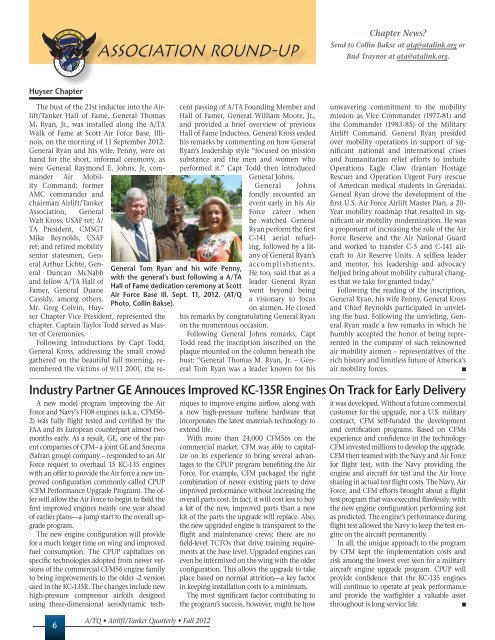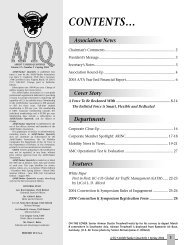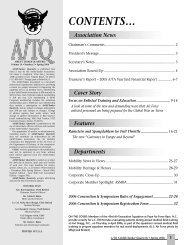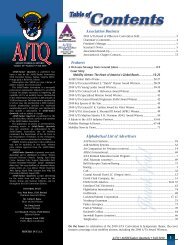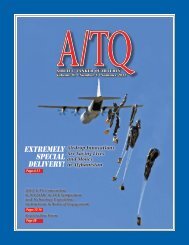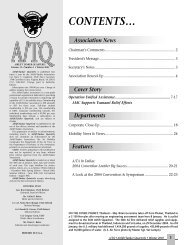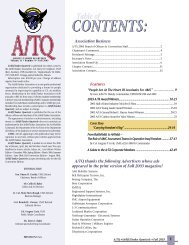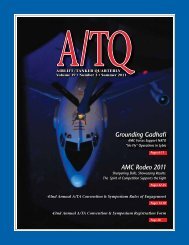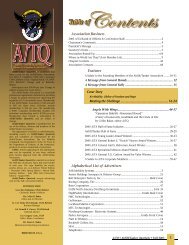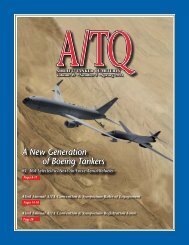A/TQ covers - Airlift/Tanker Association
A/TQ covers - Airlift/Tanker Association
A/TQ covers - Airlift/Tanker Association
You also want an ePaper? Increase the reach of your titles
YUMPU automatically turns print PDFs into web optimized ePapers that Google loves.
<strong>Association</strong> Round-Up<br />
Chapter News?<br />
Send to Collin Bakse at atq@atalink.org or<br />
Bud Traynor at ata@atalink.org.<br />
Huyser Chapter<br />
The bust of the 21st inductee into the <strong>Airlift</strong>/<strong>Tanker</strong><br />
Hall of Fame, General Thomas<br />
M. Ryan, Jr., was installed along the A/TA<br />
Walk of Fame at Scott Air Force Base, Illinois,<br />
on the morning of 11 September 2012.<br />
General Ryan and his wife, Penny, were on<br />
hand for the short, informal ceremony, as<br />
were General Raymond E. Johns, Jr, commander<br />
Air Mobility<br />
Command; former<br />
AMC commander and<br />
chairman <strong>Airlift</strong>/<strong>Tanker</strong><br />
<strong>Association</strong>, General<br />
Walt Kross, USAF ret; A/<br />
TA President, CMSGT<br />
Mike Reynolds, USAF<br />
ret; and retired mobility<br />
senior statesmen, General<br />
Arthur Lichte, General<br />
Duncan McNabb<br />
and fellow A/TA Hall of<br />
Famer, General Duane<br />
Cassidy, among others.<br />
Mr. Greg Colvin, Huyser<br />
Chapter Vice President, represented the<br />
chapter. Captain Taylor Todd served as Master<br />
of Ceremonies.<br />
Following introductions by Capt Todd,<br />
General Kross, addressing the small crowd<br />
gathered on the beautiful fall morning, remembered<br />
the victims of 9/11 2001, the re-<br />
General Tom Ryan and his wife Penny,<br />
with the general’s bust following a A/TA<br />
Hall of Fame dedication ceremony at Scott<br />
Air Force Base Ill. Sept. 11, 2012. (AT/Q<br />
Photo, Collin Bakse).<br />
cent passing of A/TA Founding Member and<br />
Hall of Famer, General William Moore, Jr.,<br />
and provided a brief overview of previous<br />
Hall of Fame Inductees. General Kross ended<br />
his remarks by commenting on how General<br />
Ryan’s leadership style “focused on mission<br />
substance and the men and women who<br />
performed it.” Capt Todd then introduced<br />
General Johns.<br />
General Johns<br />
fondly recounted an<br />
event early in his Air<br />
Force career when<br />
he watched General<br />
Ryan perform the first<br />
C-141 aerial refueling,<br />
followed by a litany<br />
of General Ryan’s<br />
accomplishments.<br />
He too, said that as a<br />
leader General Ryan<br />
went beyond being<br />
a visionary to focus<br />
on airmen. He closed<br />
his remarks by congratulating General Ryan<br />
on the momentous occasion.<br />
Following General Johns remarks, Capt<br />
Todd read the inscription inscribed on the<br />
plaque mounted on the column beneath the<br />
bust: “General Thomas M. Ryan, Jr. – General<br />
Tom Ryan was a leader known for his<br />
unwavering commitment to the mobility<br />
mission as Vice Commander (1977-81) and<br />
the Commander (1983-85) of the Military<br />
<strong>Airlift</strong> Command. General Ryan presided<br />
over mobility operations in support of significant<br />
national and international crises<br />
and humanitarian relief efforts to include<br />
Operations Eagle Claw (Iranian Hostage<br />
Rescue) and Operation Urgent Fury (rescue<br />
of American medical students in Grenada).<br />
Geneal Ryan drove the development of the<br />
first U.S. Air Force <strong>Airlift</strong> Master Plan, a 20-<br />
Year mobility roadmap that resulted in significant<br />
air mobility modernization. He was<br />
a proponent of increasing the role of the Air<br />
Force Reserve and the Air National Guard<br />
and worked to transfer C-5 and C-141 aircraft<br />
to Air Reserve Units. A selfless leader<br />
and mentor, his leadership and advocacy<br />
helped bring about mobility cultural changes<br />
that we take for granted today.”<br />
Following the reading of the inscription,<br />
General Ryan, his wife Penny, General Kross<br />
and Chief Reynolds participated in unvieling<br />
the bust. Following the unvieling, General<br />
Ryan made a few remarks in which he<br />
humbly accepted the honor of being represented<br />
in the company of such reknowned<br />
air mobility airmen – representatives of the<br />
rich history and limitless future of America’s<br />
air mobility forces.<br />
Industry Partner GE Annouces Improved KC-135R Engines On Track for Early Delivery<br />
A new model program improving the Air<br />
Force and Navy’s F108 engines (a.k.a., CFM56-<br />
2) was fully flight tested and certified by the<br />
FAA and its European counterpart almost two<br />
months early. As a result, GE, one of the parent<br />
companies of CFM– a joint GE and Snecma<br />
(Safran group) company – responded to an Air<br />
Force request to overhaul 15 KC-135 engines<br />
with an offer to provide the Air force a new improved<br />
configuration commonly called CPUP<br />
(CFM Performance Upgrade Program). The offer<br />
will allow the Air Force to begin to field the<br />
first improved engines nearly one year ahead<br />
of earlier plans—a jump start to the overall upgrade<br />
program.<br />
The new engine configuration will provide<br />
for a much longer time on wing and improved<br />
fuel consumption. The CPUP capitalizes on<br />
specific technologies adopted from newer versions<br />
of the commercial CFM56 engine family<br />
to bring improvements to the older -2 version<br />
used in the KC-135R. The changes include new<br />
high-pressure compressor airfoils designed<br />
using three-dimensional aerodynamic tech-<br />
niques to improve engine airflow, along with<br />
a new high-pressure turbine hardware that<br />
incorporates the latest materials technology to<br />
extend life.<br />
With more than 24,000 CFM56s on the<br />
commercial market, CFM was able to capitalize<br />
on its experience to bring several advantages<br />
to the CPUP program benefiting the Air<br />
Force. For example, CFM packaged the right<br />
combination of newer existing parts to drive<br />
improved performance without increasing the<br />
overall parts cost. In fact, it will cost less to buy<br />
a kit of the new, improved parts than a new<br />
kit of the parts the upgrade will replace. Also,<br />
the new upgraded engine is transparent to the<br />
flight and maintenance crews; there are no<br />
field-level TCTOs that drive training requirements<br />
at the base level. Upgraded engines can<br />
even be intermixed on the wing with the older<br />
configuration. This allows the upgrade to take<br />
place based on normal attrition—a key factor<br />
in keeping installation costs to a minimum.<br />
The most significant factor contributing to<br />
the program’s success, however, might be how<br />
it was developed. Without a future commercial<br />
customer for the upgrade, nor a U.S. military<br />
contract, CFM self-funded the development<br />
and certification programs. Based on CFMs<br />
experience and confidence in the technology<br />
CFM invested millions to develop the upgrade.<br />
CFM then teamed with the Navy and Air Force<br />
for flight test, with the Navy providing the<br />
engine and aircraft for test and the Air Force<br />
sharing in actual test flight costs. The Navy, Air<br />
Force, and CFM efforts brought about a flight<br />
test program that was executed flawlessly, with<br />
the new engine configuration performing just<br />
as predicted. The engine’s performance during<br />
flight test allowed the Navy to keep the test engine<br />
on the aircraft permanently.<br />
In all, the unique approach to the program<br />
by CFM kept the implementation costs and<br />
risk among the lowest ever seen for a military<br />
aircraft engine upgrade program. CPUP will<br />
provide confidence that the KC-135 engines<br />
will continue to operate at peak performance<br />
and provide the warfighter a valuable asset<br />
throughout is long service life.<br />
6<br />
A/<strong>TQ</strong> • <strong>Airlift</strong>/<strong>Tanker</strong> Quarterly • Fall 2012


